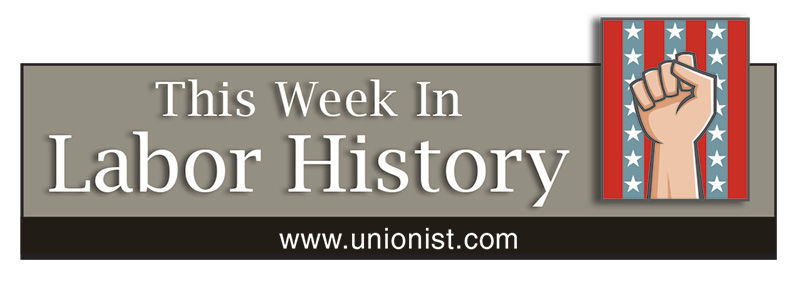
JUNE 24
1971 – Seventeen workers are killed as methane explodes in a water tunnel under construction in Sylmar, Calif.
JUNE 25
1893 – More than 8,000 people attend the dedication ceremony for The Haymarket Martyrs Monument in Chicago, honoring those framed and executed for the bombing at Haymarket Square on May 4, 1886.
1938 – Fair Labor Standards Act passes Congress, banning child labor and setting the 40-hour work week.
1941 – At the urging of Black Labor and civil rights leader A. Philip Randolph, Franklin Roosevelt issues an executive order barring discrimination in defense industries.
1943 – Congress passes the Smith-Connally War Labor Disputes Act over President Franklin Roosevelt’s veto. It allows the federal government to seize and operate industries threatened by strikes that would interfere with war production. It was hurriedly created after the third coal strike in seven weeks.
1985 – A total of 21 workers are killed when a fireworks factory near Hallett, Okla.
1994 – Decatur, Ill., police pepper-gas workers at A.E. Staley plant gate one year into the company’s two-and-a-half-year lockout of Paperworkers Local 7837.
JUNE 26
1894 – Members of the American Railway Union, led by Eugene V. Debs, refuse to handle Pullman cars, in solidarity with Pullman strikers. Two dozen strikers were killed over the course of the strike.
1959 – The 189-mile-long St. Lawrence Seaway opens, making the Great Lakes accessible to Atlantic shipping. Thousands of laborers toiled for decades to make it happen; indirectly and directly, the Seaway today supports 75,000 jobs in Canada and 150,000 in the U.S.
JUNE 27
1935 – Congress passes the National Labor Relations Act, creating the structure for collective bargaining in the United States.
1985 – A 26-day strike of New York City hotels by 26,000 workers — the first such walkout in 50 years — ends with a five-year contract calling for big wage and benefit gains.
JUNE 28
1850 – Birthday of machinist Matthew Maguire, who many believe first suggested Labor Day. Others believe it was Peter McGuire, a carpenter.
1894 – President Grover Cleveland signs legislation declaring Labor Day an official U.S. holiday.
1944 – A Liberty Ship named after the founding president of the American Federation of Labor, Samuel Gompers, is launched in Sausalito, Calif. She replaced a cargo steamship bearing Gompers’ name which had been torpedoed and sunk by a Japanese sub in the South Pacific the previous year.
1988 – The federal government sues the Teamsters to force reforms on the union, the nation’s largest. The following March, the government and the union sign a consent decree requiring direct election of the union’s president and creation of an Independent Review Board.
JUNE 29
1885 – What is to be a seven-day streetcar strike begins in Chicago after several workers are unfairly fired. Wrote the police chief at the time, describing the strikers’ response to scabs: “One of my men said he was at the corner of Halsted and Madison Streets, and although he could see 50 stones in the air, he couldn’t tell where they were coming from.” The strike was settled to the workers’ satisfaction.
1934 – An executive order signed by President Franklin D. Roosevelt establishes the National Labor Relations Board. A predecessor organization, the National Labor Board, established by the Depression-era National Industrial Recovery Act in 1933, had been struck down by the Supreme Court – 1934
1936 – Jesus Pallares, founder of the 8,000-member coal miners union, Liga Obrera de Habla Espanola, is deported as an “undesirable alien.” The union operated in northern New Mexico and southern Colorado.
1988 – The U.S. Supreme Court rules in CWA v. Beck that, in a union security agreement, a union can collect as dues from non-members only that money necessary to perform its duties as a collective bargaining representative.
JUNE 30
1928 – Alabama outlaws the leasing of convicts to mine coal, a practice that had been in place since 1848. In 1898, 73 percent of the state’s total revenue came from this source. 25 percent of all Black leased convicts died on the job.
1998 – Up to 40,000 New York construction workers demonstrated in midtown Manhattan, protesting the Metropolitan Transportation Authority’s awarding of a $33 million contract to a nonunion company. Eighteen police and three demonstrators were injured. “There were some scattered incidents and some minor violence,” Police Commissioner Howard Safir told the New York Post. “Generally, it was a pretty well-behaved crowd.”
2013 – Nineteen fire fighters die when they are overtaken by a wildfire they are battling in a forest northwest of Phoenix, Ariz. It was the deadliest wildfire involving firefighters in the U.S. in at least 30 years.
(Labor History is provided by Union Communications Services, since 1981 North America’s premier publisher and distributor of newsletters, leadership training programs for shop stewards and officers, website materials and other powerful use-it-today strategies and tools to help leaders and activists build union power. Reach them at unionist.com.)

